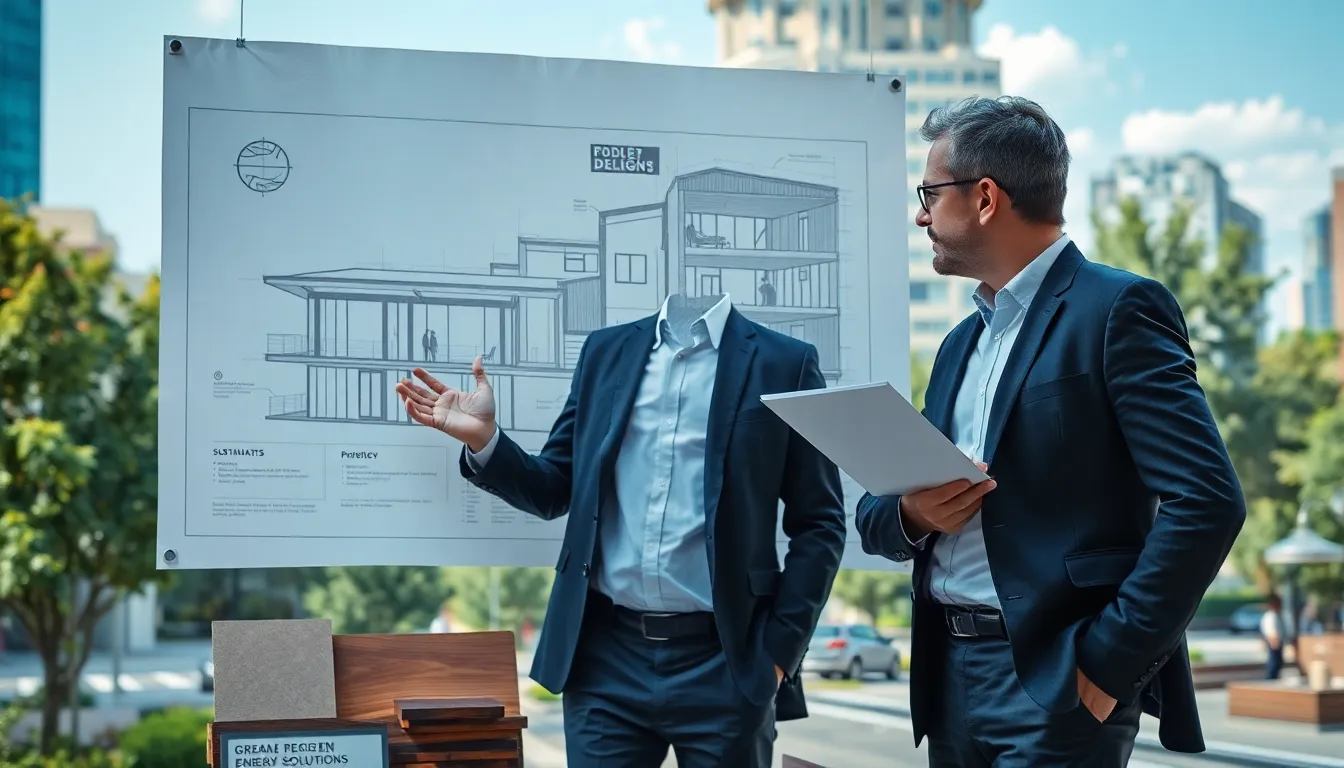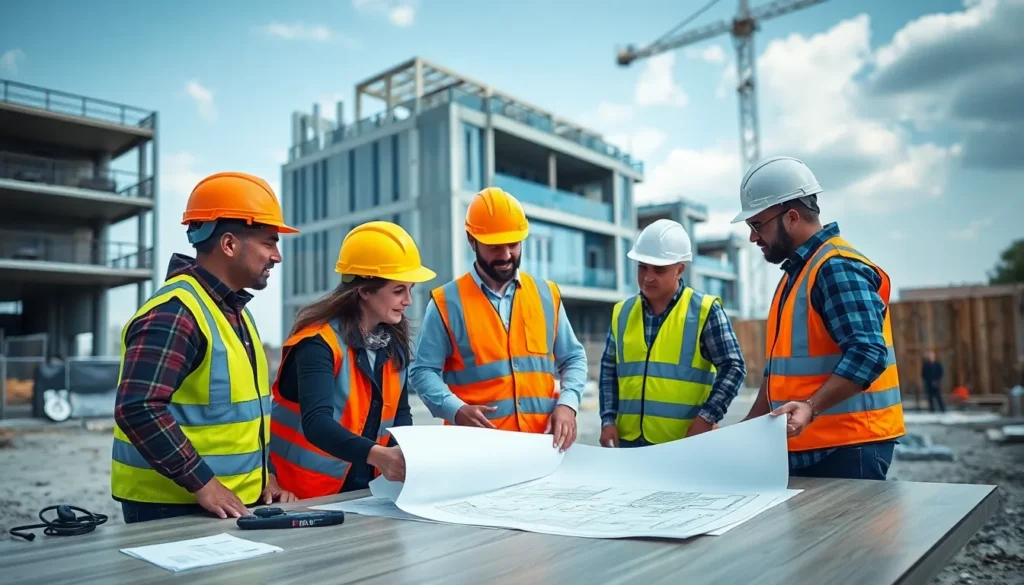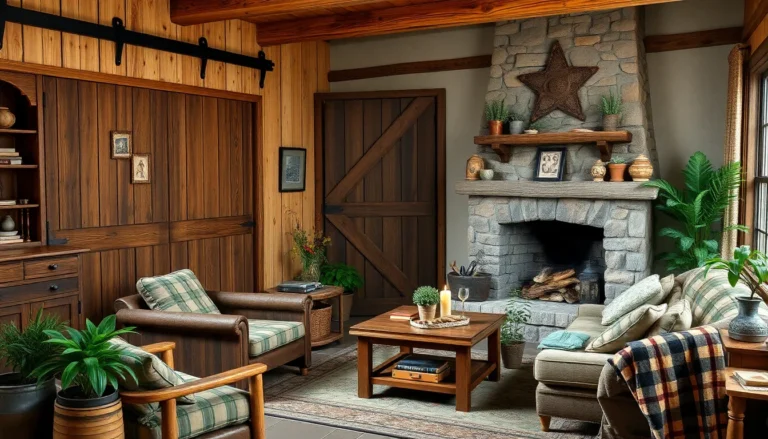Table of Contents
ToggleIn a world where buildings can either inspire awe or induce yawns, the art of building design and construction has never been more crucial. It’s not just about putting up walls and a roof; it’s about crafting spaces that breathe life into everyday experiences. Think of it as creating a cozy nest for humans, where functionality meets flair, and every corner tells a story.
Overview of Building Design and Construction
Building design and construction plays a pivotal role in shaping environments that are both functional and aesthetically pleasing. Successful designs integrate various elements, such as space planning, materials, and sustainability considerations. Architects create blueprints by considering the needs of occupants and the surrounding environment.
Construction involves the actual implementation of these designs through careful coordination of tradespeople. Skilled laborers, like electricians and plumbers, work collaboratively to bring architectural visions to life. The construction process often includes multiple phases, such as pre-construction, construction, and post-construction phases.
Sustainable practices are increasingly prioritized in contemporary projects. Many designers emphasize energy efficiency, utilizing renewable resources and eco-friendly materials. Implementing green building standards not only reduces environmental impact but also enhances occupant comfort and health.
Accessibility features remain a critical aspect of building design. These elements ensure that spaces are usable for people of all abilities. Incorporating ramps, elevators, and appropriate signage demonstrates commitment to inclusivity.
Technology also influences building design and construction. Advanced software tools aid architects in drafting detailed plans and visualizations. Innovations in construction methods, such as prefabrication and modular construction, expedite project timelines and improve quality control.
Collaboration between architects, engineers, and contractors fosters a productive environment, promoting problem-solving and creativity. Open communication streamlines the decision-making process. Each stakeholder’s input contributes to the project’s overall success, ensuring that design and construction harmonize to create vibrant, functional spaces.
Key Principles of Building Design

Building design emphasizes multiple principles that ensure spaces are appealing and functional. Well-considered elements enhance both aesthetics and usability.
Aesthetic Considerations
Aesthetics significantly influence building design. Architects prioritize visual appeal through the use of color, form, and texture. Thoughtful arrangement of windows and materials creates harmony with the surrounding landscape. Curb appeal plays a crucial role in attracting occupants, contributing to overall satisfaction. Lively public spaces invite interaction, fostering community connections. Each choice reflects the intended style, from modern minimalism to traditional designs, ensuring a coherent architectural identity.
Functional Requirements
Functional requirements govern the practicality of a space. Architects analyze space needs and flow, prioritizing efficiency in layout. Effective design must accommodate specific activities, influencing room sizes and shapes. Accessibility features, such as wider doors and designated paths, ensure everyone can use the environment comfortably. Additionally, safety regulations dictate design elements like emergency exits and structural integrity, prioritizing occupant protection. Each functional aspect ties back to user experience, making practicality a core focus.
Sustainability and Energy Efficiency
Sustainability shapes contemporary building design. Architects incorporate energy-efficient materials that minimize environmental impact. Natural light maximizes energy use, reducing reliance on artificial lighting. Utilizing renewable energy sources, like solar panels, lowers operational costs and carbon footprints. Eco-friendly materials, such as reclaimed wood and low-VOC paints, enhance indoor air quality and overall health. Regulatory frameworks increasingly support these sustainable practices, encouraging designs that balance aesthetics with environmental responsibility. Each sustainable choice reinforces the commitment to a healthier planet.
The Construction Process
The construction process consists of several crucial phases that ensure successful project completion.
Planning and Permitting
Planning involves detailed site assessments and feasibility studies. Local regulations dictate the permitting process, requiring adherence to zoning laws and building codes. Architects and engineers collaborate to develop plans that align with these regulations. Engaging stakeholders early streamlines communication and identifies potential obstacles. Securing the necessary permits takes time, so anticipating requirements helps avoid delays. Project timelines hinge on efficient planning, emphasizing the need for thorough preparation.
Materials Selection
Materials selection plays a vital role in overall building performance. Sustainable materials enhance energy efficiency and reduce the carbon footprint. Architects examine options based on durability, cost, and aesthetic appeal. Local sourcing often lowers transportation impacts and supports the community. Designers prioritize materials that comply with safety standards while offering longevity. Innovative products, like recycled or reclaimed materials, are increasingly popular, promoting environmental responsibility without sacrificing quality.
Project Management Techniques
Effective project management techniques ensure timely completion and budget adherence. Clear communication among contractors, architects, and clients fosters collaboration and minimizes misunderstandings. Regular progress meetings help assess timelines and address challenges promptly. Utilizing technology, such as project management software, enhances organization and tracking. Risk management strategies identify potential issues early, allowing for proactive solutions. Emphasizing these techniques leads to smoother workflows and successful project outcomes.
Innovations in Building Design and Construction
Innovations are transforming the landscape of building design and construction, revolutionizing how structures are conceived and executed.
Smart Building Technologies
Smart building technologies integrate Internet of Things (IoT) devices to optimize energy efficiency and enhance occupant experiences. Sensors monitor temperature, lighting, and occupancy, allowing real-time adjustments for comfort and savings. Automated systems can manage HVAC, security, and energy consumption, reducing operational costs significantly. Integration of these technologies leads to improved sustainability, making buildings more eco-friendly. Data analytics further assists in maintenance by predicting system failures before they occur. Architects increasingly incorporate these features into designs, ensuring spaces are not only functional but highly adaptable to user needs.
Prefabrication and Modular Construction
Prefabrication and modular construction streamline the building process through off-site fabrication of components. These methods enhance efficiency and cut construction time by up to 50%, minimizing on-site disruptions. Each module is constructed in a controlled environment, ensuring consistent quality and reducing waste. Environmental benefits arise from utilizing sustainable materials and energy-efficient practices during production. Architects and builders value the flexibility of modular designs, allowing for easy modifications and scalability. This approach not only accelerates project completion but also fosters innovative design possibilities, making it a preferred option in modern construction.
Challenges in the Industry
Building design and construction face various challenges that can impact project success and quality. Notable issues include regulatory compliance and financial constraints.
Regulatory Compliance Issues
Navigating regulatory compliance presents significant hurdles for professionals in the industry. Building codes and zoning laws vary by location, requiring extensive research and adherence to numerous regulations. Each jurisdiction imposes its own standards, affecting designs and materials used. Missing a compliance requirement can result in costly delays or legal repercussions. Ongoing changes in regulations further complicate the landscape, necessitating continuous education for architects and contractors to stay current. Collaboration with local authorities helps streamline the process, but often, it requires substantial effort to align all stakeholders with local regulations.
Cost Overruns and Time Delays
Cost overruns and time delays frequently plague construction projects, causing stress for teams involved. Unforeseen site conditions or material shortages often inflate budgets and extend timelines. Effective project management techniques are vital, yet even strict adherence to schedules can falter due to external factors. Weather conditions can disrupt timelines, while labor shortages can impact workforce availability. Regular communication among team members helps identify potential issues early, improving responsiveness. Prioritizing risk management strategies allows project leaders to address problems proactively, minimizing the negative effects on both costs and schedules.
Building design and construction play a pivotal role in shaping environments that are both functional and inviting. By prioritizing sustainability and accessibility, architects and builders create spaces that cater to diverse needs while minimizing environmental impact.
The integration of advanced technologies and innovative practices streamlines the construction process, enhancing efficiency and quality. Collaboration among various stakeholders fosters creativity and problem-solving, ensuring that each project not only meets but exceeds expectations.
Ultimately, the commitment to blending aesthetics with practicality results in spaces that inspire and enrich the lives of those who inhabit them. As the industry continues to evolve, the focus on responsible design and construction will remain essential for creating vibrant communities.








